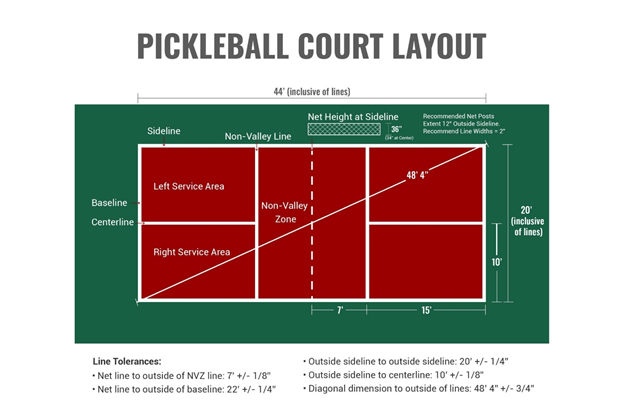Pickleball Court Construction Price Guide-- What to Anticipate
Pickleball Court Construction Price Guide-- What to Anticipate
Blog Article
Lasting Practices in Pickleball Court Building And Construction You Should Know
As the popularity of pickleball remains to climb, so also does the need for lasting techniques in court building and construction. This strategy not just addresses environmental concerns however additionally improves the durability and performance of the courts. From picking environmentally friendly products to applying effective drainage and energy-saving lights options, there are numerous strategies to think about. Yet, the effect of these techniques extends much beyond the court itself. Comprehending how each aspect adds to a much more lasting future invites better exploration into the intricate balance between leisure development and environmental stewardship.
Selecting Eco-Friendly Products
Picking green materials is an important action in the construction of sustainable pickleball courts. The option of sustainable materials not just minimizes environmental effect but likewise boosts the longevity and performance of the court. Secret products consist of reused rubber for the surface, which uses superb sturdiness and shock absorption while diverting waste from garbage dumps.
In addition, utilizing locally sourced materials decreases transportation emissions and supports regional economic climates. Pickleball court construction. Using native woods for secure fencing and seats can give a sustainable aesthetic while ensuring strength against the elements.
Including absorptive materials for court foundations can further add to sustainability by enabling natural water drainage and minimizing overflow. These selections not only shield neighborhood ecological communities but additionally promote healthier play settings.
Efficient Drain Solutions
While the selection of green materials is essential, carrying out reliable drainage solutions is similarly essential for maintaining sustainable pickleball courts. Proper water drainage not only secures the court surface from water damage but also decreases disintegration and overflow, promoting environmental stability.
Effective drainage systems can include absorptive paving, which permits water to penetrate the ground as opposed to merging externally. This lowers the likelihood of standing water, which can lead to mold and various other maintenance issues. Additionally, including purposefully positioned drain channels and swales can route excess water away from the court area, ensuring a completely dry playing surface area and stopping dirt disintegration.
Using native vegetation in the landscape design around the courts can even more enhance water drainage by taking in excess water and reducing overflow. These plants require much less irrigation and advertise biodiversity, aligning with lasting practices.
Furthermore, it is crucial to consistently preserve the drainage system to ensure its long-lasting performance. This includes clearing particles and tracking for clogs. By focusing on efficient water drainage options, pickleball court contractors can considerably add to the sustainability and longevity of the facility, inevitably profiting both players and the atmosphere.
Energy-Efficient Lighting Options
As the demand for pickleball continues to expand, integrating energy-efficient lights choices into court style has actually ended up being increasingly crucial for sustainability. he said Standard lighting systems frequently eat too much power, adding to higher functional expenses and environmental effect. Embracing contemporary, energy-efficient technologies is important for both brand-new constructions and remodellings.
LED (Light Emitting Diode) lighting stands apart as a leading option due to its longevity and energy financial savings (Pickleball court construction). Compared to traditional illumination, LEDs utilize around 75% much less energy and can last approximately 25 times longer, considerably reducing maintenance prices. Additionally, the directional nature of LED illumination decreases light pollution, ensuring that lighting is focused on the court rather than surrounding areas.
Sustainable Surface Area Alternatives
Discovering sustainable surface area alternatives for pickleball courts has actually obtained grip amongst gamers and building contractors alike. The emphasis on eco-friendly products not only straightens with the growing ecological understanding but likewise enhances the efficiency and durability of the courts.
This material supplies excellent shock absorption, minimizing the threat of injuries for players while promoting sustainability. These ceramic tiles are simple to change and mount, and their convenience permits for different court configurations.
Natural lawn courts are additionally emerging as a sustainable selection, advertising biodiversity and minimizing the warm island effect. They require regular upkeep and water, which may not straighten with all sustainability objectives.

Water Conservation Methods

An additional reliable Visit Your URL method involves the installment of rain harvesting systems. These systems gather and save rain for usage in maintaining court surfaces and landscaping. This technique not only preserves drinkable water however likewise reduces reliance on metropolitan resources.
Additionally, using drought-resistant landscape design around the courts is vital. Indigenous plants call for much less water and are much better adapted to local climate problems, hence lowering total water usage. Furthermore, using reliable watering systems, such as drip watering, makes certain that water is delivered directly to plant origins, decreasing dissipation and waste.
Conclusion
Integrating lasting practices in pickleball court building and construction considerably adds to ecological preservation and resource efficiency. By focusing on these practices, the building and construction of pickleball courts can align with wider ecological objectives visit here while promoting longevity and performance within areas.
As the appeal of pickleball proceeds to climb, so also does the need for sustainable methods in court building.Picking eco-friendly materials is a vital action in the building and construction of lasting pickleball courts. By focusing on energy-efficient illumination choices, pickleball court producers can add to a much more sustainable future while fulfilling the demands of gamers and stakeholders alike.Integrating sustainable surface choices not just improves the efficiency of pickleball courts yet likewise paves the way for implementing reliable water preservation techniques.Including lasting practices in pickleball court construction significantly adds to ecological conservation and resource efficiency.
Report this page